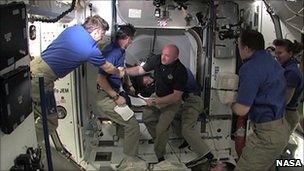Shuttle Endeavour docks at International Space Station
- Published
Endeavour performed a back-flip before docking with the ISS
The US space shuttle Endeavour has arrived at the International Space Station (ISS).
The orbiter, which is making its last foray above the planet, will spend just under two weeks at the platform.
It is delivering a $2bn particle physics experiment and a tray of critical spare parts.
On its return to Earth on 1 June, Endeavour will be prepared for public display at the California Science Center in Los Angeles.
The ship completed the now traditional flip manoeuvre just prior to docking, to allow astronauts on the ISS to photograph all of the shuttle's surfaces.
This imagery will be sent to Earth to be assessed by engineers, who will check to see the orbiter has sustained no damage during its launch on Monday or during the two-journey to get to the ISS.
Beyond Endeavour, the US space agency (Nasa) plans one further shuttle mission to the station in July.
America will then use Russian Soyuz capsules to fly its astronauts to the ISS, before a number of US national commercial carriers enter service and take up the role sometime in the middle of the decade.
Endeavour's crew was led through the hatch into the ISS by their commander Mark Kelly.
The veteran of three previous shuttle flights is the husband of Arizona congresswoman Gabby Giffords, who was shot in the head by a gunman at one of her constituency meetings in January.
She has made remarkable steps in her recovery since the attack, enabling Kelly to leave Earth for 16 days to take part in the mission.

Shuttle commander Mark Kelly is greeted by the ISS crew as he climbs aboard
The Endeavour crew's key task ahead will be to fit the Alpha Magnetic Spectrometer (AMS) to the top of the ISS.
The machine, which has taken 17 years to prepare, will undertake a comprehensive survey of cosmic rays.
These are the high-energy particles that are accelerated in Earth's direction from all corners of the cosmos.
Scientists hope that in characterising these particles they can learn more about how the Universe came into being and how is it constructed.
The astronauts will use the robotic arms of both Endeavour and the ISS to put the detector in place on Thursday.

Shuttle Atlantis is currently being prepared for a final mission sometime in July
- Published16 May 2011
- Published29 April 2011
- Published27 April 2011